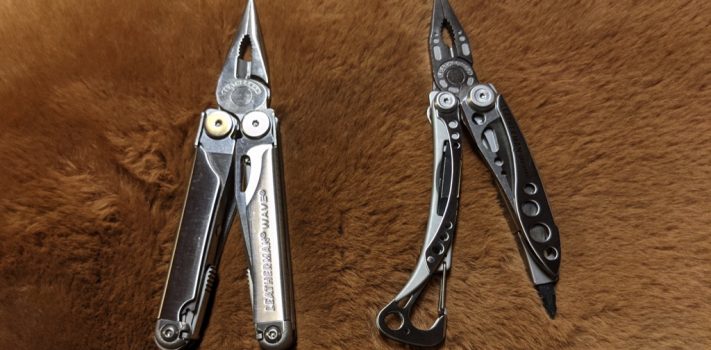It was a beautiful late-July evening in southeastern Alaska. I was on a work team helping a missionary supported by our church. The missionary’s organization was updating an old fishing lodge to serve as a halfway house. The goal was to provide a place to mentor native Alaskans who had recently been released from prison.
I was tired in a good way. We had been busy all day clearing land at the lodge for a sawmill site. Now we were enjoying a quiet evening. A friend from church was fishing on the river nearby. I was just watching, because I was too frugal to buy a non-resident fishing license for just a few days of use. As you can tell, I am not a true fisherman.
Before long, my friend caught a nice salmon. He took out his Leatherman Wave to remove the hook. I had been considering getting a Leatherman Wave. When my friend was done removing the hook, I asked if I could take a look at his Wave. I was quite impressed with the item. It seemed to be exactly what I was looking for in a multi-tool. It had the extra benefit of being made in the USA.
It can be dangerous to admire something that belongs to a friend. Later that week, my friend presented the tool to me as a gift, along with a leather sheath to carry it in. My friend reported that the tool was an extra that he had picked up inexpensively at a pawn shop.
Customer Service
The multi-tool that my friend gave me had just one flaw: the scissors were broken. I went to the Leatherman website, and completed a warranty request. The website provided me with a shipping label which I printed and then used to ship the knife to Leatherman for repair. About ten days later I received it back as good as new, free of charge. (Or maybe it really was a brand new one. I am not entirely sure). I am very impressed with their warranty service.
Basic Description
 Like many multi-tools, the Leatherman Wave is built around a folding pair of pliers. While the unit remains folded, a three-inch plain edge knife and a three-inch serrated edge knife can be opened one-handed. With the help of the other hand, a wood saw or a file can also be accessed while the unit remains folded.
Like many multi-tools, the Leatherman Wave is built around a folding pair of pliers. While the unit remains folded, a three-inch plain edge knife and a three-inch serrated edge knife can be opened one-handed. With the help of the other hand, a wood saw or a file can also be accessed while the unit remains folded.
 Unfolding the unit gives access to the pliers, which include an integral wire cutter. The handles are marked so that they can be used as either an eight-inch or 20 centimeter ruler. Folding out from the handles are #1 Phillips and flat head screwdrivers, a can opener, scissors, eyeglasses screw-sized Phillips and flat screwdrivers, and a large flat screwdriver.
Unfolding the unit gives access to the pliers, which include an integral wire cutter. The handles are marked so that they can be used as either an eight-inch or 20 centimeter ruler. Folding out from the handles are #1 Phillips and flat head screwdrivers, a can opener, scissors, eyeglasses screw-sized Phillips and flat screwdrivers, and a large flat screwdriver.
EveryDay Carry
I experimented with everyday carry of the Wave in the leather sheath. It just did not work out for me. The sheath stuck out just a little too far from my belt, and I kept getting it snagged on things. I finally abandoned the idea.
Eventually, a friend received a Leatherman Skeletool for Christmas. He showed it to me, and I was impressed. I wondered if the pocket clip might be used to secure the tool inside the waistband of a pair of pants.
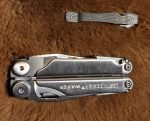 I said to myself, “It is a shame that they don’t make a pocket clip for the Wave.” And then the thought crossed my mind, “Maybe they do.” A quick Internet search revealed that this was indeed the case. Further research revealed that the actual Leatherman brand pocket clip is made from stainless steel. An Australian company called “Donk!”, on the other hand, makes a titanium clip for the Wave that users report being more durable than the stainless Leatherman clip. With that in mind, I ordered a clip from Donk! to test on my Wave.
I said to myself, “It is a shame that they don’t make a pocket clip for the Wave.” And then the thought crossed my mind, “Maybe they do.” A quick Internet search revealed that this was indeed the case. Further research revealed that the actual Leatherman brand pocket clip is made from stainless steel. An Australian company called “Donk!”, on the other hand, makes a titanium clip for the Wave that users report being more durable than the stainless Leatherman clip. With that in mind, I ordered a clip from Donk! to test on my Wave.
When the clip arrived, I quickly and securely latched it in the purpose-designed slot next to one of the locking levers on the Wave. A lanyard ring also comes with the clip, and can be latched into the slot instead of the clip.
I removed my trusty Ontario RAT 1 from inside my waistband below my right kidney, and replaced it with the Wave. It felt fine at first. Over the next few hours I began to feel some disquiet. The disquiet grew into a sense of discomfort. The discomfort matured into a throbbing pain. The Wave was just a little too large to comfortably carry in that position. I tried shifting it to the small of my back, and below my left kidney. It did not work out in either position. I finally gave up, removed the Wave, and slipped the RAT 1 back into place.
Conclusions Regarding the Wave
The Wave remains an excellent choice for my pack or pocket, but I can’t seem to carry it comfortably inside my waistband. It is sharp, versatile, durable, has a meaningful warrantee coupled with good customer service, and is made in the United States. What is not to like.
The Leatherman Skeletool
About the time that I was ordering the clip for the wave, I was also bidding on some used Skeletools on eBay. I did not win any of the auctions for the used multi-tools. Finally I bid on a brand new Skeletool. Much to my surprise, I won that auction at $40.
The Skeletool was scheduled to be delivered eight days after the close of the auction. But it was delivered after 10 days.
Opening the Box
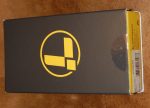 Opening the shipping box revealed a well-packed product box that was just right. It was sturdy but not ostentatious. Opening the product box revealed an instruction card in five languages (English, French, German, Spanish, and Polish). The multi-tool lay under the instruction card in a molded cardboard tray.
Opening the shipping box revealed a well-packed product box that was just right. It was sturdy but not ostentatious. Opening the product box revealed an instruction card in five languages (English, French, German, Spanish, and Polish). The multi-tool lay under the instruction card in a molded cardboard tray.
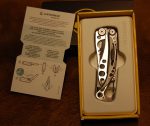 The tool feels very nice in the hand. A well-crafted piece of stainless steel is a beautiful thing. A 2.5 inch half plain/half-serrated knife blade with a liner lock can be opened with one hand without unfolding the tool. Using the integrated pocket clip, the knife slid easily inside the waistband position below my right kidney. The tool also includes a combination carabineer/bottle opener, pliers with wire cutters, and a screwdriver with two double-sided bits (#1 and #2 Phillips on the one, and 1/4″ and 3/16″ flathead on the other). The active bit can be detached by pressing a release lever, and rotated or replaced with the second bit, which is stored in a slot in the frame. Other bits are also available from Leatherman.
The tool feels very nice in the hand. A well-crafted piece of stainless steel is a beautiful thing. A 2.5 inch half plain/half-serrated knife blade with a liner lock can be opened with one hand without unfolding the tool. Using the integrated pocket clip, the knife slid easily inside the waistband position below my right kidney. The tool also includes a combination carabineer/bottle opener, pliers with wire cutters, and a screwdriver with two double-sided bits (#1 and #2 Phillips on the one, and 1/4″ and 3/16″ flathead on the other). The active bit can be detached by pressing a release lever, and rotated or replaced with the second bit, which is stored in a slot in the frame. Other bits are also available from Leatherman.
The Skeletool is the same thickness as my Ontario RAT 1, but is 3/4″ shorter (4.25″ versus 5″).
Much to my surprise, I found my first name laser engraved on the tool. As I reviewed the product offer, I could not find any indication in the description that the order included custom engraving. I am glad that I did not buy the tool as a gift for another person. I must admit that my pleasure at having the tool personalized removed most of my irritation about the slow shipping.
The Vacuum Cleaner Repair Test
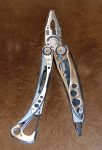 One of my first opportunities to test the tool came when my wife asked me to replace the damaged power cord on her vacuum cleaner. This process involved opening an access hatch by removing four screws with the #2 Phillips screwdriver, removing the two screws securing the cord clamp with the #2 Phillips screwdriver, cutting the old cord away with the wire cutter, cutting the undamaged cord off a broken carpet shampooer with the wire cutter, stripping insulation off the good cord and the wires within using the knife, cutting the cable tie holding the wiring harness together inside the vacuum with the knife, cutting off the crimp connectors with the wire cutter, stripping the wires on the vacuum side with the knife, attaching the cord to the vacuum wiring with wire nuts, re-securing the wiring harness with a new cable tie, cutting off the cable tie tail with the knife, reinstalling the cord clamp screws with the #2 Phillips screwdriver, and re-securing the access hatch screws with the #2 Phillips screwdriver.
One of my first opportunities to test the tool came when my wife asked me to replace the damaged power cord on her vacuum cleaner. This process involved opening an access hatch by removing four screws with the #2 Phillips screwdriver, removing the two screws securing the cord clamp with the #2 Phillips screwdriver, cutting the old cord away with the wire cutter, cutting the undamaged cord off a broken carpet shampooer with the wire cutter, stripping insulation off the good cord and the wires within using the knife, cutting the cable tie holding the wiring harness together inside the vacuum with the knife, cutting off the crimp connectors with the wire cutter, stripping the wires on the vacuum side with the knife, attaching the cord to the vacuum wiring with wire nuts, re-securing the wiring harness with a new cable tie, cutting off the cable tie tail with the knife, reinstalling the cord clamp screws with the #2 Phillips screwdriver, and re-securing the access hatch screws with the #2 Phillips screwdriver.
I was pleased to be able to do the entire job utilizing only the Skeletool.
The Boot Lace Test
Another early opportunity for testing the Skeletool was creating and threading a new set of laces into my warmest pair of boots.
I first attempted to make the new laces out of paracord.
Paracord, by the way, is what motivated me to begin writing for SurvivalBlog in the first place. I noticed that second prize in the writing contest included, “Two 1,000-foot spools of full mil-spec U.S.-made 750 paracord.” Paracord is wonderfully useful, and at the time I simply did not have enough. So I sat down and wrote my first article for SurvivalBlog.
I did not win second place in the writing contest with that or any other entry. But I enjoyed writing so much that I just kept it up. Eventually God, in His grace, supplied the paracord I wanted. My wife found a good supply in an assortment of colors at a thrift store. And so for the past years and a half or so, all of our paracord needs have been abundantly supplied, and we still have a good stock on hand. And I continue to have tremendous fun writing for SurvivalBlog.
But back to my boots. As I mentioned, I first tried to make the new laces out of paracord. The melted ends of the paracord were just too thick to fit through the eyelets. I tried reducing the size of the ends by clamping them with the pliers from the Skeletool while they were warm. I was not able to squeeze them down sufficiently to make them fit.
Fortunately, I had some line that I had salvaged from a retractable dog leash with a broken spring. I cut the line to the proper length using the knife on the Skeletool, and then fused the ends using a candle flame. The 3/16″ flat screwdriver on the Skeletool helped me finesse the new laces through the eyelets. The experiment was a complete success.
Every Day Carry
I removed the Ontario RAT 1 from the waistband below my right kidney and began carrying the Skeletool instead. Even though the Skeletool is approximately the same thickness as the RAT 1, it is more knobby and angular. It was not exactly uncomfortable to carry the Skeletool at first, but it was not quite as comfortable as carrying the RAT 1.
Over the course of weeks, the area over the back of my right iliac crest became increasingly tender. Eventually, I shifted the Skeletool over below the left kidney. Over the course of weeks, the area over the back of my left iliac crest also became increasingly tender. I finally abandoned the attempt to carry the Skeletool inside the waistband, and replaced it with my trusty RAT 1.
Conclusion
 The Leatherman Skeletool is small enough to wear with reasonable comfort inside the waistband of a pair of pants for a limited period of time (days rather than weeks and months). It contains a truly useful assortment of tools. If it had scissors, I could use the Skeletool to replace both the Victorinox MiniChamp that I have carried in my left front pocket for decades and the Ontario RAT 1 that I have carried inside my waistband for close to a year now. If I started carrying the Skeletool, I would have to switch to pocket carry, since I did not find it suitable for long-term carry inside the waistband.
The Leatherman Skeletool is small enough to wear with reasonable comfort inside the waistband of a pair of pants for a limited period of time (days rather than weeks and months). It contains a truly useful assortment of tools. If it had scissors, I could use the Skeletool to replace both the Victorinox MiniChamp that I have carried in my left front pocket for decades and the Ontario RAT 1 that I have carried inside my waistband for close to a year now. If I started carrying the Skeletool, I would have to switch to pocket carry, since I did not find it suitable for long-term carry inside the waistband.
Disclaimer
I did not receive any financial or other inducement to mention any vendor, product, or service in this article.

